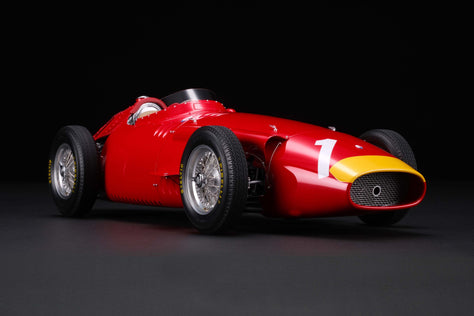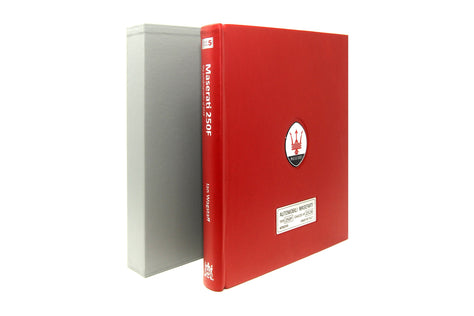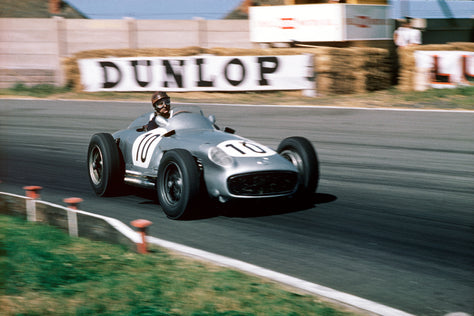Technical Details
- Description
- Scale guide
- Each model hand-built and assembled by a small team of craftsmen
- 1:18 scale model, over 23 cms/9 inches long
- Made using the finest quality materials
- Over 800 hours to develop the model
- Precisely engineered parts: castings, photo-etchings and CNC machined metal components
- Built using original CAD designs developed from the scan of an original 250F
Quite possibly the most beautiful Formula 1 car to ever race, and most definitely one of the most iconic post-war race cars, the Maserati 250F was remarkable as much for the longevity of its successful racing career as the list of drivers who graced its steering wheel. The 250F raced at the pinnacles of motorsport in an age of rapid development, debuting in 1954 and still battling hard in 1960, spanning a golden though often difficult and dangerous era of Grand Prix racing. Most famously raced by two of the greats in Grand Prix history, Juan Manuel Fangio and Stirling Moss, the 250F is widely considered the definitive front-engine Grand Prix racer.
Born out of the 2.5 litre regulations new for the 1954 Formula 1 season, the 250F followed the lines of Maserati's Formula 2 racers of 1952 and 1953. Former Ferrari engineers Gioacchino Colombo and Valerio Colotti were lured from Maranello to Modena to work alongside project lead Giulio Alfieri. A simple tubular frame carried the suspension, aluminium body panels and engine. The front suspension was independent by wishbones and coil springs. The rear used a DeDion type axle, made popular by the front engined Mercedes-Benz Grand Prix racers of the 1930s. All in all, the setup was far from revolutionary, but the straightforward design did make it a popular choice with privateers, including a certain Stirling Moss, who purchased one with his race winnings.
For 1957, an all-new multi-tubular spaceframe chassis was laid down. It followed the same lines but was considerably lighter and stronger than the much more conventional original. The drum brakes remained, though with improved stopping power and cooling characteristics. The latest version of the straight six engine was carried over but was not mounted off-set in the new ‘Tipo 2’ or ‘T2’ chassis. Work on a brand-new engine with twin overhead camshafts commenced in 1956. An engineering work of art, the 2.5 litre V12 produced 320 bhp at a startling 12,000 rpm. That was a whole 50 bhp more than the straight six. The V12 would only make one racing appearance for the works team, before the cash-strapped marque retired from international racing at the end of the 1957 season. It remained the most powerful car built during the 2.5 litre era.
In all, the 250F was entered into 46 Formula 1 World Championship races through a mammoth 277 entries, earning eight victories, eight pole positions and 10 fastest laps. Success was not limited to official events, with race wins coming at Goodwood, Pescara, Pau, Aintree, Oulton Park, Modena, Buenos Aires, Rome and Bordeaux, to name a few. Famous drivers include Fangio and Moss, who took all eight of those official victories, and also Jean Behra, Hans Herrmann, Jo Bonnier, Masten Gregory, Maria Teresa de Filippis, Peter Collins, Roy Salvadori and Luigi Musso. 26 cars were built over the course of the 250F’s five year production span and every car was unique, constructed with differing features as the design evolved. Other cars may have been more successful, but few have ever done it with such style.
This fine 1:18 scale model of the Maserati 250F is a perfect replica of the car raced to a legendary victory by Juan Manuel Fangio in the German Grand Prix at the Nürburgring on the 4th August 1957. Regularly cited as Fangio’s greatest drive, if not the greatest in all racing history, the 46-year old Argentine overturned a deficit of almost a minute to win the race and his fifth World title. Fangio started on pole ahead of the Ferrari Mike Hawthorn, but whilst the Ferrari would run a traditional non-stop race, the Maserati would be pitting for fresh tyres and fuel. A slow start would see the Argentine drop behind Hawthorn and his teammate Peter Collins, starting from fourth, but Fangio would retake the lead on lead three. He maintained his lead, setting four new lap records in the process, eventually pulling in for his pit stop at the end of lap 12.
The pit stop was a disaster; the mechanic removing the rear left wheel lost the wheel nut under the car, taking half a minute to find it. Fangio entered the pit lane with a 28 second advantage; he left 48 seconds behind Collins in second place, who himself had gone faster than Fangio’s new record. After a couple of laps running in his tyres, Fangio began to mount a charge, gaining as much as a second per mile on lap 15. Setting lap record after lap record, the Argentine reeled in his Ferrari rivals overtaking both on the twenty-first and penultimate lap, holding the British duo to take a race victory by 2.8 seconds that would forever cement his and the 250F’s names in Formula 1 folklore for ever more. Perhaps it was fitting then, that this would be the last victory Fangio would take in Formula 1.
Note: This is a 'Kerbside' model and does not any feature moving parts.
Pre-order
Bespoke
In order for us to create your bespoke model, you will need to choose 4 extra options. Paint colour, interior colour, wheel style and caliper colour.
Please complete the form and a member of our Sales Team will contact you.
Contact Us
Please contact us for more information about ordering this model.


![[hide-in-gallery]](http://www.amalgamcollection.com/cdn/shop/files/Realimageedit_2000x850_crop_center.jpg?v=1712318337)



